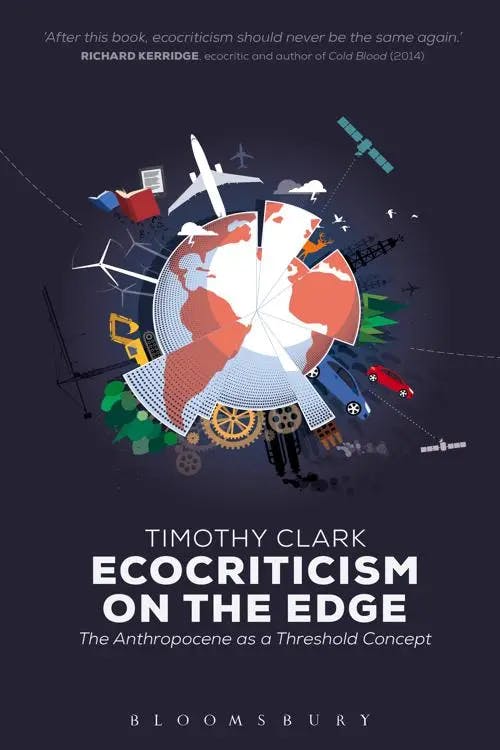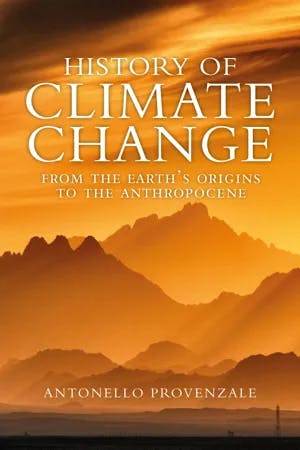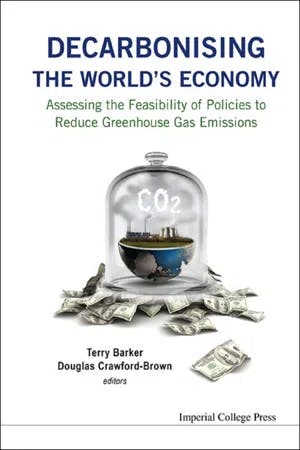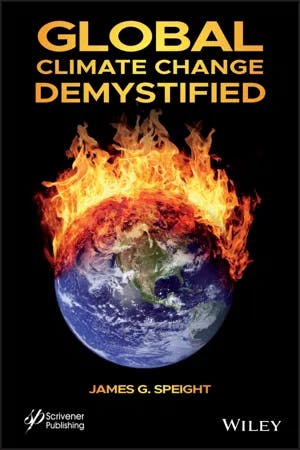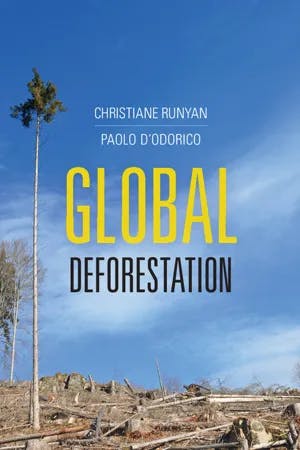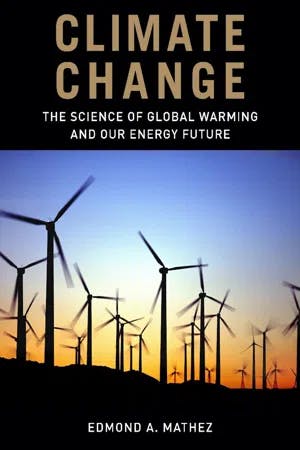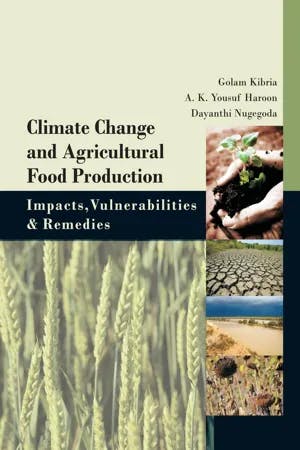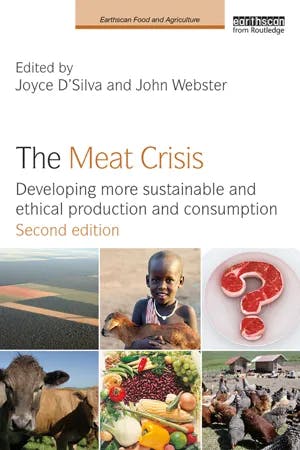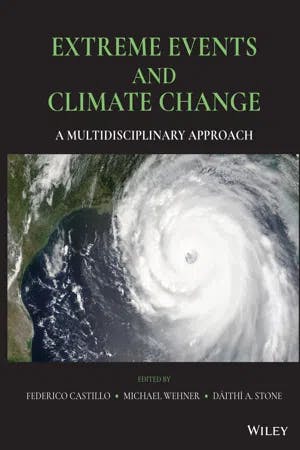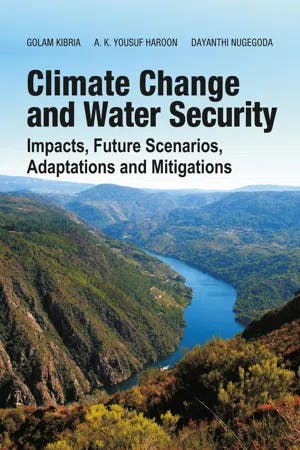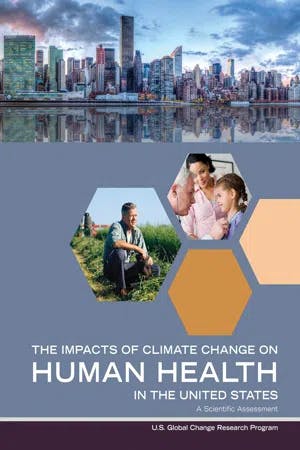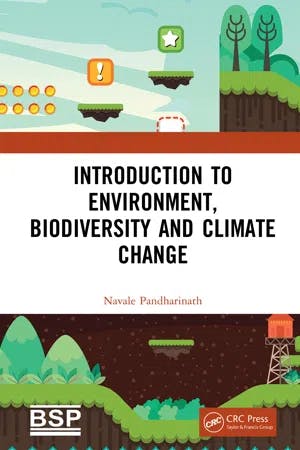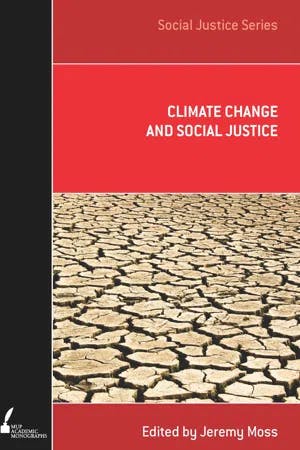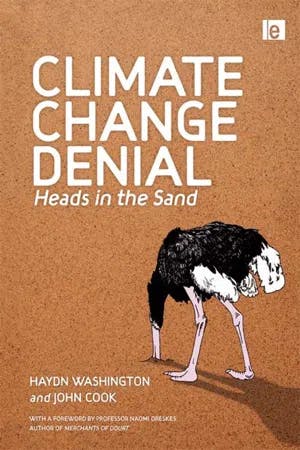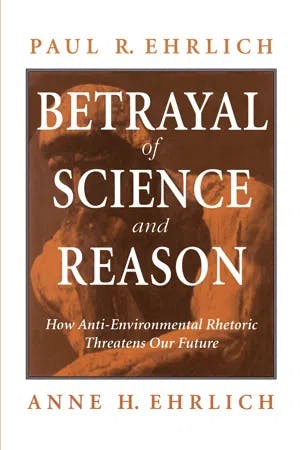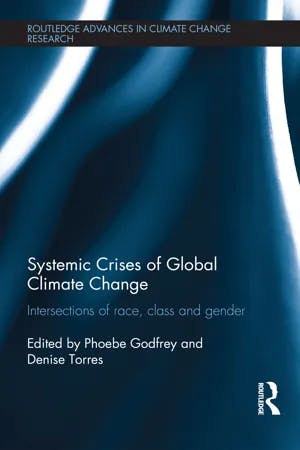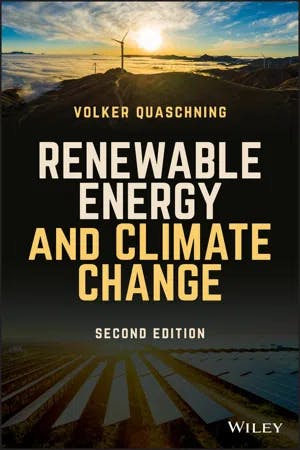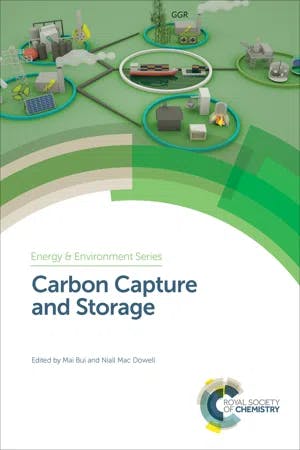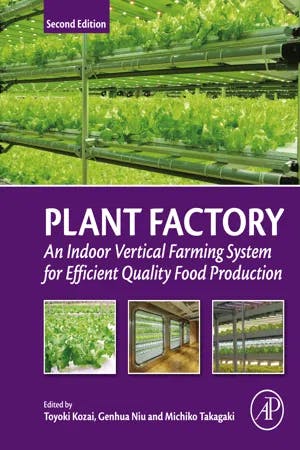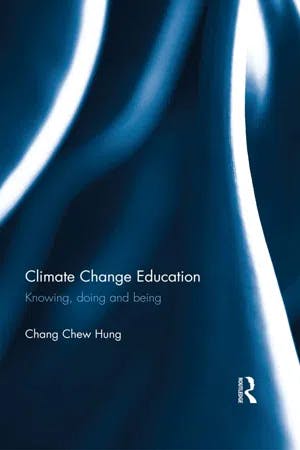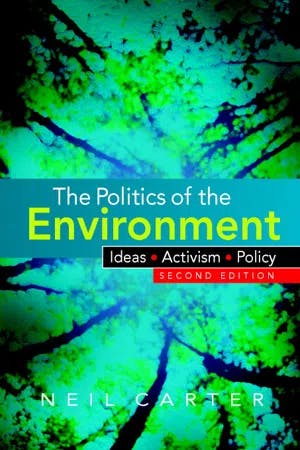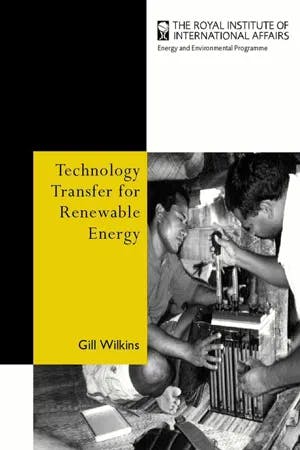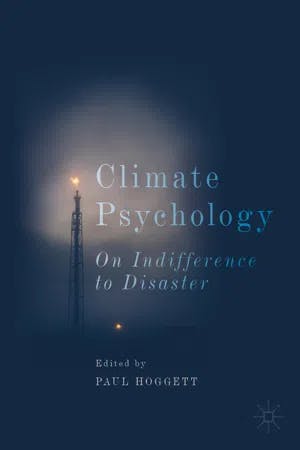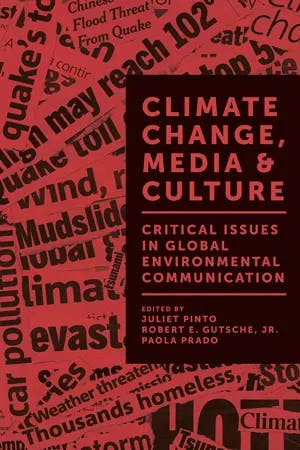What is Climate Change?
PhD, Environmental Humanities (University of Glasgow)
Date Published: 13.12.2023,
Last Updated: 02.04.2024
Share this article
Note, this article sits under Creative Commons License CC-BY-NC.

Defining climate change
Climate change describes a long-term shift in weather patterns around the world, which have been rapidly accelerating since the 1800s due to human activity. Examples of climate change include rising global temperatures, the melting of the polar ice caps, and an increasing loss of biodiversity. As a result of this, the conditions of living in the 21st century are often characterized by the accumulation of, as Timothy Clark puts it,
environmental issues that are truly planetary in scale, notably climate change, ocean acidification, effects of overpopulation, deforestation, soil erosion, overfishing and the general and accelerating degradation of ecosystems. (2010)
Timothy Clark
environmental issues that are truly planetary in scale, notably climate change, ocean acidification, effects of overpopulation, deforestation, soil erosion, overfishing and the general and accelerating degradation of ecosystems. (2010)
Climate change has become an existential threat, prompting widespread calls for government intervention in the 21st century. For example, in August 2018, 15-year-old Swedish student Greta Thunberg, made headlines when she refused to go to school, instead opting to sit outside of parliament with a sign reading “School Strike for Climate.” Thunberg was frustrated at the government’s lack of intervention in the climate crisis. Her strike prompted other students to follow suit, creating Fridays for Future, a global school strike for climate.
Concern over climate change has increased exponentially in recent years, with the Office for National Statistics (ONS) reporting in 2022 that 74% of adults surveyed reported feeling worried about climate change; climate change was also reported as the second biggest concern facing adults after the rising cost of living (“Worried about climate change, Great Britain,” 2022).
Although climate change has gained significant attention in recent years, it has a long history that goes beyond the headlines we see today. The historical context of climate change reveals a gradual and complex process that has been unfolding over centuries, driven by various natural and anthropological factors.
Historic climate change
Whilst there have been historic climate variations, the impact of human activity over the past two centuries has been a cause for great concern. It has prompted governments across the world to implement policies and take measures to mitigate the worst effects of climate change. In History of Climate Change, Antonello Provenzale states that
The climate of our planet is continually changing. At certain periods in its history, the Earth was hot and lush with forests, and at others, it was almost entirely covered by a thick layer of ice. At times, there have been crocodiles at the North Pole, and at others, ice at the equator. Over the course of millions of years, sudden rises in temperature caused by massive volcanic eruptions have been followed by slow cooling periods associated with the dance of the continents, moved by convective motions in the Earth’s mantle. And all of this has been punctuated, every so often, by monstrous catastrophes that have swept away most of that epoch’s living beings. (2023)
Antonello Provenzale
The climate of our planet is continually changing. At certain periods in its history, the Earth was hot and lush with forests, and at others, it was almost entirely covered by a thick layer of ice. At times, there have been crocodiles at the North Pole, and at others, ice at the equator. Over the course of millions of years, sudden rises in temperature caused by massive volcanic eruptions have been followed by slow cooling periods associated with the dance of the continents, moved by convective motions in the Earth’s mantle. And all of this has been punctuated, every so often, by monstrous catastrophes that have swept away most of that epoch’s living beings. (2023)
However, since the Industrial Revolution in the nineteenth century, climate change has been occurring at an accelerated speed, as a result of increased industrialization and consumption wrought through capitalism. We have, in the past two centuries, burned fossil fuels at an exorbitant rate, exacerbating what is known as “the greenhouse effect”.
According to the annual report from NOAA’s Global Monitoring Lab, carbon dioxide in the atmosphere was 417.06 parts per million (ppm), setting a new record high. The report adds:
The amount of CO2 in the atmosphere today is comparable to where it was around 4.3 million years ago during the mid-Pliocene epoch, when sea level was about 75 feet higher than today, the average temperature was 7 degrees Fahrenheit higher than in pre-industrial times and studies indicate large forests occupied areas of the Arctic that are now tundra. (NOAA, “Greenhouse gases continued to increase rapidly in 2022,” 2023)
The IPCC has predicted that meeting targets of 350 ppm will stabilize greenhouse gas emissions (European Environmental Agency, “Climate change targets: 350 ppm and the EU two-degree target,” 2016).
Global warming, greenhouse gases, the greenhouse effect
The phrase “global warming” is often used synonymously with “climate change,” however, it is important to note that, while the two terms are closely related, global warming is just one aspect of climate change.
Global warming refers to the long-term increase of the planet’s temperature. The main reason for this is the greenhouse effect. The greenhouse effect describes how greenhouse gases (carbon dioxide, methane, nitrous oxide, and water vapor) trap heat in the Earth’s atmosphere, resulting in an increase in the planet’s temperature. In itself, the greenhouse effect is not problematic and is a natural phenomena; in fact, it is a necessity to sustain life on Planet Earth. However, as Douglas Crawford-Brown and Martin Sewell explain, the increased burning of fossil fuels in the past century has caused greenhouse gases to “accumulate in the atmosphere” and
trap the sun’s heat more effectively, increasing the energy absorbed in the atmosphere, which is in part transferred to the oceans and land masses. This heat is then moved globally through various processes such as the ocean currents (surface and bottom) and the high altitude cells of air that carry energy from the equator to the poles and back. This will, in the long run, result in increased mean global temperatures, although there will be variability across the surface of the earth, with some areas cooling while others heat up. (“The Case for Decarbonisation,” in Decarbonising The World's Economy, 2014)
Edited by Terry Barker & Douglas Crawford-Brown
trap the sun’s heat more effectively, increasing the energy absorbed in the atmosphere, which is in part transferred to the oceans and land masses. This heat is then moved globally through various processes such as the ocean currents (surface and bottom) and the high altitude cells of air that carry energy from the equator to the poles and back. This will, in the long run, result in increased mean global temperatures, although there will be variability across the surface of the earth, with some areas cooling while others heat up. (“The Case for Decarbonisation,” in Decarbonising The World's Economy, 2014)
Since the pre-industrial period, the Earth’s global temperature has increased by one degree per decade; this has been attributed to human activities (“What is Climate Change?”, NASA)
Causes of climate change
As per the example of the greenhouse effect, climate change is the result of both natural processes and human activity. Human activity activity however is what exacerbates many of these natural processes, resulting in a series of cascading ecological effects around the globe. Below we have detailed out some of these natural and human factors.
Natural factors
Natural factors which have contributed to global warming include solar radiation and volcanic activity. As James G. Speight explains in Global Climate Change Demystified,
the changes in solar output can affect the climate by changing the rate of solar heating of the Earth and atmosphere, and indirectly, by changing cloud forming processes. Thus, consideration of the amount of solar radiation (the albedo) is important when investigating the reasons (or forcings) behind climate change. (2019)
James G. Speight
the changes in solar output can affect the climate by changing the rate of solar heating of the Earth and atmosphere, and indirectly, by changing cloud forming processes. Thus, consideration of the amount of solar radiation (the albedo) is important when investigating the reasons (or forcings) behind climate change. (2019)
Put simply, global climate change, particularly the melting of ice, decreases the Earth’s albedo (i.e., the reflectivity of its surface) meaning that more energy from the sun is absorbed, thus warming the planet. Volcanic eruptions also contribute CO2 to the atmosphere, further contributing to the greenhouse effect. However, as Speight points out
Changes in solar irradiance have contributed to climate trends over the past century but since the Industrial Revolution, the effect of additions of greenhouse gases to the atmosphere has also been recognized. (2019)
Human factors
The scientific consensus is that climate change is predominantly the result of human activity over the past two centuries. As Crawford-Brown and Sewell write,
It was not until the Industrial Revolution of the 18th and 19th centuries that atmospheric concentrations of carbon dioxide began to increase appreciably due to human activities (other geological periods have also shown appreciable increases and decreases, but for reasons other than human influence), rising from 280 ppm (parts per million) before the Industrial Revolution to above 390 ppm today. This has been accompanied by an increase in global average surface air temperatures. The increase in average surface temperature across the globe that has occurred over the past 150 years appears to be of the order of 0.6°C ± 0.2°C during the 20th century; best scientific estimates are that this increase could become larger by several degrees celcius by 2100 due to increases in [greenhouse gases] from human activity. (2014)
The emissions of greenhouse gases, resulting from energy use, industrialization, increase in aviation, advances in technology, and patterns of consumption and production, have contributed significantly to climate change.
Greenhouse gas emissions and generating power
Greenhouse gases are emitted due to human activity in both the residential and economic sectors. According to the Environmental Protection Agency, US greenhouse gas emissions come from the following sources in 2021:
Transport: Transportation accounted for 28% of greenhouse gas emissions with over 94% of fuel used for transportation being comprised of gasoline and diesel.
Electricity: Emissions arising from electricity production made up 25% of greenhouse gas emissions.
Industry: Industry was responsible for 23% of greenhouse gases in this year. These gas emissions primarily came from burning fossil fuels for energy and from chemical reactions in the production of goods.
Commercial and residential: This sector accounted for 13% of greenhouse gas emissions. This area covers the burning of fossil fuels for energy in homes and commercial buildings, as well as emissions from handling waste.
Agriculture: 10% of greenhouse gas emissions in 2021 came from livestock, agricultural soils, and rice production.
(“Sources of Greenhouse Gas Emissions”, 2023)
Deforestation
Another way that humans have contributed to climate change is through deforestation. Deforestation describes the clearing of large sections of forests in order to repurpose the land, for agricultural expansion, and to extract timber and other materials.
Forest ecosystems play a significant role in water-cycle regulation and carbon-dioxide absorption (reducing the impact of the greenhouse effect), as well as providing a habitat for a diverse array of animal and plant species. In Global Deforestation, Christiane Runyan and Paolo D'Odorico write,
The long-term loss of forest resources affects not only the functioning of ecosystems but also the societies, health, and livelihoods of those dependent upon them. (2016)
The long-term loss of forest resources affects not only the functioning of ecosystems but also the societies, health, and livelihoods of those dependent upon them. (2016)
Overconsumption and waste
The abundance of choice (in terms of food, fashion, and technology etc) in wealthy countries has led to excessive consumption and waste, contributing to the deterioration of our planet.
Food waste, for instance, is at an all-time high with approximately one third of food production lost or wasted globally, equivalent to 1.3 billion tons, per year (World Food Programme, “5 facts about food waste and hunger,” 2020). In developing countries, 40% of wastage occurs at post-harvest and processing levels, in comparison to industrialized countries where over 40% of waste occurs at retail and consumer level (World Food Programme, 2020). As the World Wide Fund for Nature (WWF) puts it,
When we waste food, we also waste all the energy and water it takes to grow, harvest, transport, and package it. And if food goes to the landfill and rots, it produces methane—a greenhouse gas even more potent than carbon dioxide. About 6%-8% of all human-caused greenhouse gas emissions could be reduced if we stop wasting food. In the US alone, the production of lost or wasted food generates the equivalent of 32.6 million cars’ worth of greenhouse gas emissions. (“Fight climate change by preventing food waste,” 2023)
The fast-fashion industry is a major contributor to greenhouse gas emissions, from the production of the clothes to the rapid rate in which garments are discarded into landfill. As Nikolay Anguelov explains, production in the fashion industry “creates more toxic chemical pollution per item than any other industrial product” with 20% of all water pollution coming from “the runoff processes of textile dyeing and rinsing of natural (mostly cotton) fabrics” (The Dirty Side of the Garment Industry, 2015). Anguelov goes on to state that “the final dis-posal of used clothes disproportionately occurs in the developing world, where there are few, if any, regulatory standards in waste management,” thus resulting in these clothes decomposing in soil and waterways (2015).
Population increase
Population growth is a key contributor to climate change. The human population has tripled in size since the 1950s and is expected to grow to over 8.5 billion in 2030 (“Population growth, environmental degradation and climate change,” United Nations). This growth has been attributed to the increase of the average lifespan and high fertility levels. The UN goes on to state that, while population growth is slowing down,
given the intrinsic momentum of population growth, the range of plausible trajectories of global population over the next few decades is quite narrow. For this reason, further actions by Governments to limit the growth of populations would do little to mitigate the forces of climate change between now and 2050.
The overpopulation argument, however, may disproportionately place the blame for the climate crisis on the developing world, in which populations are typically higher than in industrialized countries. As Heather Alberro points out
Blaming human population growth – often in poorer regions – risks fuelling a racist backlash and displaces blame from the powerful industries that continue to pollute the atmosphere. Developing regions in Africa, Asia and Latin America often bear the brunt of climate and ecological catastrophes, despite having contributed the least to them. (“Why we should be wary of blaming ‘overpopulation’ for the climate crisis,” The Conversation, 2020)
Moreover, blaming populations in the developing world obscures the main drivers of climate change: overconsumption under modern capitalism.
It is clear to see from agricultural practices to overconsumption that human activity has had a huge, and detrimental, impact on the world we live in. To learn more about human impact on the climate, see our guide “What is the Anthropocene?”
Evidence of climate change
The IPCC’s 2023 Climate Change Report (referred to as the AR6 Synthesis Report) indicates the observable evidence for climate change, such as increased global temperatures, extreme weather events, and impacts on ecosystems. This section will refer to the findings presented in the IPCC’s report, as well as evidence from the Copernicus Climate Change Service (C3S), the Centre for Climate and Energy Solutions (C2ES), and The United States Environmental Protection Agency (EPA).
Increased temperatures
The warming of the atmosphere, ocean, and land has resulted in rapid and significant changes throughout the climate system. Greenhouse gas emissions are highly likely the main driver of tropospheric warming (i.e., warming of the lower layer of the Earth’s atmosphere), while human-caused stratospheric ozone depletion is extremely likely responsible for stratospheric cooling (i.e., cooling at 10-50 km above the Earth’s surface). The global upper ocean has warmed since the 1970s, accounting for 91% of heating in the climate system, land warming (5%), ice loss (3%) and atmospheric warming (1%). The global sea level has increased by 0.20m between 1901 and 2018. There has been a “global retreat of glaciers since the 1990s,” a decrease in the Northern Hemisphere spring snow cover, the surface melting of the Greenland ice sheet, and acidification of the surface open ocean (IPCC, AR6 Report, 2023.) The IPCC also states that human activity is very likely responsible for all of these climate changes.
Extreme weather events
Observed climate extremes across the globe include:
- Heatwaves: Deputy Director of Copernicus Climate Change Service (C3S), Samantha Burgess states that:
October 2023 has seen exceptional temperature anomalies, following on from four months of global temperature records being obliterated. We can say with near certainty that 2023 will be the warmest year on record, and is currently 1.43°C above the preindustrial average. The sense of urgency for ambitious climate action going into COP28 has never been higher. (“2023 on track to become the warmest year after record October”)
- Heavy precipitation: The IPCC point out that “heavy precipitation has increased in many regions since the 1950s” and “substantially more people (~709 million) live in regions where annual maximum one-day precipitation has increased than regions where it has decreased (~86 million)” (AR6 Report, 2023).
- Droughts: 2020 saw widespread drought in the US (Centre for Climate and Energy Solutions, C2ES).
- Tropical cyclones: The United States Environmental Protection Agency (EPA) reports that cyclone intensity has increased over the past twenty years and eight out of the ten most active years of cyclone activity since 1950 have occurred since the mid-1990s.
IPCC further notes that the attribution of these events to human activity has strengthened since the last report, AR5, in 2014.
Impact on ecosystems
The IPCC note that
Climate change has caused substantial damages, and increasingly irreversible losses, in terrestrial, freshwater, cryospheric and coastal and open ocean ecosystems (high confidence) (AR6 Report, 2023).
The report adds that the scope and scale of the impacts on ecosystems have exceeded those outlined in previous reports. Their findings are as follows:
Approximately half of the species assessed globally have moved towards the poles, on land, as well as to higher altitudes.
Changes in geographical placement or shifting of seasonal timing will not be enough to mitigate the impact of recent climate change.
Biological responses such as changes in geographical placement or shifting seasonal timing are often not enough to cope with recent climate change
Hundreds of species have been lost due to heightened heat extremes and “mass mortality events on land and in the ocean”
These impacts on ecosystems may be irreversible.
(IPCC, AR6 Report, 2023)
Each of these findings has been rated as “very high confidence” or “high confidence.”
Global impact of climate change
These extreme weather events carry significant, often fatal, risks. As Edmond Mathez explains in Climate Change,
Some of these consequences are potentially dire and may have significant negative impacts on our well-being: extensive and severe drought that may affect agriculture; significant decreases in water supplies for the large proportion of world population that depends on ice and snowmelt for its water; increased incidence of severe weather events, and displacement of huge numbers of people as sea level rises; spread of plant and animal disease; collapse of whole ecosystems; and significant decreases in biodiversity. These consequences are the risks involved in global warming, and we need to recognize them as such in formulating rational responses to an uncertain future. (2016)
Some of these consequences are potentially dire and may have significant negative impacts on our well-being: extensive and severe drought that may affect agriculture; significant decreases in water supplies for the large proportion of world population that depends on ice and snowmelt for its water; increased incidence of severe weather events, and displacement of huge numbers of people as sea level rises; spread of plant and animal disease; collapse of whole ecosystems; and significant decreases in biodiversity. These consequences are the risks involved in global warming, and we need to recognize them as such in formulating rational responses to an uncertain future. (2016)
Effects on agriculture
Climate change has had a major impact on the agricultural sector from decreasing the viability of crop growth to creating health challenges specific to agricultural workers.
In Climate Change and Agricultural Food Production (2021), Golam Kibria, A. K. Yousuf Haroon, and Dayanthi Nugegoda explore how climate change has already affected agriculture across the globe, and outline future risks in this sector. This study also takes into account some of the positive potential impacts of climate change on the agriculture industry, such as fewer cold-stress-related deaths (resulting in lower lamb mortality) and increases in crop yields in East and South East Asia. Climate change’s negative impact on agriculture, however, is significant and includes:
- higher rates of cattle mortality from heat stress-related deaths
- reduced rainfall in Africa resulting in less staple food production
- a decrease in crop yields in Central and South Asia, South West Australia, Southern Europe and Latin America
- incidents of pests, parasites and decreases in the polar regions
- tropical cyclones and, subsequently, crop damage on small islands.
- reduction in animal weight, reproduction rates and milk yields
(2021)
Edited by Kibria, Golam Et.Al.
- higher rates of cattle mortality from heat stress-related deaths
- reduced rainfall in Africa resulting in less staple food production
- a decrease in crop yields in Central and South Asia, South West Australia, Southern Europe and Latin America
- incidents of pests, parasites and decreases in the polar regions
- tropical cyclones and, subsequently, crop damage on small islands.
- reduction in animal weight, reproduction rates and milk yields
(2021)
It is worth noting that, while agriculture is at risk due to climate change, it is also a major contributor to climate change, producing enormous rates of both CO2 and methane. In “Livestock and Climate Change,” Tara Garnett explains that
Apart from the potential welfare implications of how we actually rear these animals, the growth in livestock farming has damaging consequences for biological diversity, for water extraction and use, for soil and air pollution – and for climate change [...] tackling climate changing emissions will require us to reduce the number of animals we rear and to change the way we rear them; and we will need to eat fewer foods of animal origin. This said, livestock production can also very much form a part of the solution – farm animals can help create a resilient, sustainable, biodiverse food system, if we rear them in the right way and at moderate scales. (Garnett in The Meat Crisis, 2017)
Edited by Joyce D'Silva & John Webster
Apart from the potential welfare implications of how we actually rear these animals, the growth in livestock farming has damaging consequences for biological diversity, for water extraction and use, for soil and air pollution – and for climate change [...] tackling climate changing emissions will require us to reduce the number of animals we rear and to change the way we rear them; and we will need to eat fewer foods of animal origin. This said, livestock production can also very much form a part of the solution – farm animals can help create a resilient, sustainable, biodiverse food system, if we rear them in the right way and at moderate scales. (Garnett in The Meat Crisis, 2017)
Flooding and storms
In Extreme Events and Climate Change, Jennifer M. Collins and Charles H. Paxton outline the impact of tropical cyclones:
Well‐developed tropical cyclones bring an array of impacts including (1) damaging wind, (2) storm surge flooding, (3) tornadoes, (4) and rainfall flooding. Flooding is the primary killer within tropical cyclones and is generated from storm surge and/or from the rainfall. (“Tropical Cyclone Impacts,” 2021)
Edited by Federico Castillo, Michael Wehner & Dáithí A. Stone
Well‐developed tropical cyclones bring an array of impacts including (1) damaging wind, (2) storm surge flooding, (3) tornadoes, (4) and rainfall flooding. Flooding is the primary killer within tropical cyclones and is generated from storm surge and/or from the rainfall. (“Tropical Cyclone Impacts,” 2021)
Kibria, Yousuf Haroon, and Nugegoda further highlight the secondary impacts of flooding, including water-related diseases such as cholera (2020).
Droughts and wildfires
Climate change can impact the quantity of available and safe water, thus impacting agriculture, livestock, fisheries, and aquaculture. (“Climate Change and Water Adaptation Issues,” European Environmental Agency, 2007).
The C2ES further found that drought, resulting from water scarcity, increases the incidence of wildfires:
The frequency of large fires was nearly four times greater in the 14-year period from 1987 to 2003 than in the preceding 14 years. In addition, the total area burned was more than six times greater; the burn time (time from discovery to control) increased from 7.5 to 37.1 days; and the length of the fire season was longer by 78 days per year. (“Wildfires and Climate Change”)
Rising sea levels and coastal impacts
Kibria, Yousuf Haroon, and Nugegoda point out that sea-level rise will result in the chloride contamination of groundwater and may result in the following:
- Damage or destruction of “ many coastal ecosystems including wetlands”
- Intrusion of saline water in agriculture and freshwater aquaculture facilities
- Loss of biodiversity
- Loss of livelihoods of people depending on mangroves for wood, timber, medicines, honey, fruits, fisheries. (SLR can cause a shift in community composition of mangrove forest since mangrove species differ in their tolerance to sea level rise.)
(2020)
Golam Kibria, A. K. Yousuf Haroon & Dayanthi Nugegoda
- Damage or destruction of “ many coastal ecosystems including wetlands”
- Intrusion of saline water in agriculture and freshwater aquaculture facilities
- Loss of biodiversity
- Loss of livelihoods of people depending on mangroves for wood, timber, medicines, honey, fruits, fisheries. (SLR can cause a shift in community composition of mangrove forest since mangrove species differ in their tolerance to sea level rise.)
(2020)
Health impacts
Climate change has been cited as a major reason for health concerns across the globe, particularly in areas with weak health infrastructure and those less able to respond to environmental emergencies. The World Health Organization (WHO) estimates the direct damage costs to health (not including costs in health-determining sectors such as agriculture, water, and sanitation) as being between $2-4 billion per year by 2030. WHO further indicates that 2 billion people lack safe drinking water and 600 million suffer from foodborne illnesses annually, with children under five bearing 30% of all foodborne fatalities. Climate change heightens the risk of waterborne and foodborne diseases and subsequent fatalities.
Research published by the US Global Change Research Program further highlights the myriad of ways that climate change can impact public health, writing that:
The influences of weather and climate on human health are significant and varied. They range from the clear threats of temperature extremes and severe storms to connections that may seem less obvious. For example, weather and climate affect the survival, distribution, and behavior of mosquitoes, ticks, and rodents that carry diseases like West Nile virus or Lyme disease. Climate and weather can also affect water and food quality in particular areas, with implications for human health. In addition, the effects of global climate change on mental health and well-being are integral parts of the overall climate-related human health impact. (2018)
US Global Change Research Program
The influences of weather and climate on human health are significant and varied. They range from the clear threats of temperature extremes and severe storms to connections that may seem less obvious. For example, weather and climate affect the survival, distribution, and behavior of mosquitoes, ticks, and rodents that carry diseases like West Nile virus or Lyme disease. Climate and weather can also affect water and food quality in particular areas, with implications for human health. In addition, the effects of global climate change on mental health and well-being are integral parts of the overall climate-related human health impact. (2018)
Rising temperatures associated with global warming may also have health implications:
Recent research attributes 37% of heat-related deaths to human-induced climate change. Heat-related deaths among those over 65 have risen by 70% in two decades. (WHO, “Climate Change,” 2023)
Castillo et al echo this concern in their study on heatwaves and agricultural labor:
In the complex production and employment context of California agriculture, climate changes such as an increase in the frequency and intensity of heat waves may have significant consequences. [...] Research results show that heat exposure can have significant health effects, which include heat cramps, heat stroke, heat syncope, and death. (“The Impact of Heat Waves on Agricultural Labor Productivity and Output,” in Extreme Events and Climate Change)
The impacts of climate change on an individual’s health vary from person to person and research has shown that those on low incomes suffer disproportionately from climate change, owing to lack of access to healthcare and due to the areas in which they live. This will be covered in further detail later in this guide.
Climate change and biodiversity
Climate change has had significant impacts on biodiversity, ecosystems, and ecological interactions. Droughts, rising temperatures, and pollution have resulted in the destruction of habitats, forcing many species to migrate whilst pushing others to the verge of extinction. As Navale Pandharinath writes,
The application of technology in twentieth century not only brought benefits but also brought decline in the environmental quality and threatening to effect the available natural resources for the present and future generations besides causing damage to the health of living being and extinction of some species of life. Thus technology proved to be both Boon and Bane to life on earth. [...] the state of environment has substantially declined in quality due to increasing pollution, loss of vegetation cover and loss of biological diversity. (2021)
Navale Pandharinath
The application of technology in twentieth century not only brought benefits but also brought decline in the environmental quality and threatening to effect the available natural resources for the present and future generations besides causing damage to the health of living being and extinction of some species of life. Thus technology proved to be both Boon and Bane to life on earth. [...] the state of environment has substantially declined in quality due to increasing pollution, loss of vegetation cover and loss of biological diversity. (2021)
Species migration and extinction
The IPBES Global Assessment on Biodiversity and Ecosystem Services (2019) reported on the impacts of climate change on animal and plant species. The report found that around 1 million animal and plant species may go extinct within decades - more than ever before in human history. In addition, the report found that the abundance of native species in most land-based habitats has decreased by 20% since 1900; more than 40% of amphibian species, almost 33% of reef-forming corals and more than a third of all marine mammals are at risk.
So what exactly is causing the depletion of plant and animal species?
One major risk to marine life is ocean acidification. The ocean absorbs 30% of CO2 which is released into the atmosphere as a result of burning fossil fuels. When CO2 is absorbed, a chemical reaction occurs resulting in an increased concentration of hydrogen ions, and a decrease of carbonate ions. Carbonate ions are essential for organisms such as oysters, clams, sea urchins, corals, and calcareous plankton as they are used to build and maintain shells. Moreover, the acidification of seawater can decrease fish’s ability to detect predators. For more on this, see Stacy Alaimo’s “Your Shell on Acid: Material Immersion, Anthropocene Dissolves” in Anthropocene Feminism.
In addition to this, increased water temperature can result in coral bleaching. Coral bleaching involves the expelling of algae living in coral tissue, resulting in coral turning completely white. Coral bleaching means corals are at higher risk of mortality. According to the National Ocean Service, in 2005 the US lost half its coral reef in the Caribbean in one year due to a bleaching event (“What is Coral Bleaching?”).
The reduction of land-based species is due to a range of factors associated with climate change, including habitat loss due to deforestation, overexploitation of species, pollution, hunting and forced migration.
Debunking climate change myths
Overwhelming data from reputable organizations such as WHO and IPCC attest to the reality and severity of climate change. As Cam Walker states,
Mainstream debate about global warming has shifted considerably in the past half decade. Rather than being reported as a contested science, human-induced global warming is now accepted as fact by nearly all governments and is a matter of major concern for the Australian public. (“Climate Refugees and New Understandings of Security,” in Climate Change and Social Justice, 2009)
Edited by Jeremy Moss
Mainstream debate about global warming has shifted considerably in the past half decade. Rather than being reported as a contested science, human-induced global warming is now accepted as fact by nearly all governments and is a matter of major concern for the Australian public. (“Climate Refugees and New Understandings of Security,” in Climate Change and Social Justice, 2009)
Despite this evidence, some deny that climate change is real, or doubt that it will have a significant impact on future generations. In Climate Change Denial, Haydn Washington further argues that,
Many climate change deniers call themselves climate ‘skeptics’; indeed there is a ‘climate skeptics’ political party in Australia (www.climatesceptics.com.au). However, refusing to accept the overwhelming ‘preponderance of evidence’ is not skepticism, it is denial and should be called by its true name. (2013)
Haydn Washington
Many climate change deniers call themselves climate ‘skeptics’; indeed there is a ‘climate skeptics’ political party in Australia (www.climatesceptics.com.au). However, refusing to accept the overwhelming ‘preponderance of evidence’ is not skepticism, it is denial and should be called by its true name. (2013)
So what are some of the common myths around climate change that have resulted in the climate denial Washington describes?
Climate change deniers often argue that the climate is susceptible to change, and that the extreme weather, melting sea ice, rising global temperatures and global loss of biodiversity in the 21st century is natural. This myth has been debunked through evidence that in the last two centuries (since the Industrial Revolution) global warming has significantly increased (Crawford-Brown and Sewell, 2014; IPCC, 2023), outside of any “natural” limits.
Other climate myths are based upon facts, however. For example, some climate deniers cite the fact that plants need CO2, thus positing that CO2 is not damaging. However, this is only true in part. In Betrayal of Science and Reason, Paul R. Ehrlich and Anne H. Ehrlich point out that studies on plant exposure to CO2 have not managed to capture the scale of global warming:
Because of such complexities and the problems of scale, scientists can at best make informed guesses about whether any positive effects of CO2 fertilization will compensate for negative effects of CO2-induced rapid climate change. (2013)
Paul R. Ehrlich & Anne H. Ehrlich
Because of such complexities and the problems of scale, scientists can at best make informed guesses about whether any positive effects of CO2 fertilization will compensate for negative effects of CO2-induced rapid climate change. (2013)
Similar to this argument, is the notion that animals will simply adapt to climate change. Whilst some animals may be able to adapt to some of the changes to the environment, not all will. Moreover, any adaptations will likely be insufficient to deal with the drastic environmental changes (Radchuk et al, “Adaptive responses of animals to climate change are most likely insufficient,” 2019).
Another common myth is that an influx of record-low temperatures refute the idea of Earth warming. As the Environmental Defense Fund (EDF) indicates, the more the planet warms, the more water is evaporated into the atmosphere, resulting in more precipitation (“4 reasons climate change is here, even though it's cold”, 2023). This is in-part why the terms “climate change” and “global warming” require differentiating - our changing climate is felt both in the rising average global temperatures as well as the erratic swings in temperature we see.
Whilst such myths have been debunked, they unfortunately are not, as Ehrlich and Ehrlich explain, printed in reputable journals where they must stand up to scientific scrutiny. Instead, these views are circulated publicly where they have garnered support from those in power:
With strong and appealing messages, [climate denialists] have successfully sowed seeds of doubt among journalists, policy makers, and the public at large about the reality and importance of such phenomena as overpopulation, global climate change, ozone depletion, and losses of biodiversity. (Ehrlich and Ehrlich, 2013)
They go on to state that:
Despite the evidence and deepening consensus among scientists, humanity seems to be engaged in a remarkable episode of folly. Folly—pursuing policies injurious to self-interest while being advised against them—is nothing new; it has plagued governments since their inception. What has changed through the ages is not the lack of wisdom in politics but rather the price to be paid for that lack. Despite a vastly enhanced understanding of our planet’s life-support systems, humanity is continually assaulting them—degrading and destroying within a few generations the ecosystems that provide the very basis of civilization. (Ehrlich and Ehrlich, 2013)
Social justice
Many researchers have pointed out that climate change has, and will continue to have, disproportionate impacts on vulnerable communities. While it is easy to say that “human activity” has caused climate change, it’s vital to ask “which humans?” Introspection into this question shines a light on an ongoing injustice, wherein those responsible for the effects of climate change are often those least impacted by those effects. For instance, Greta Gaard demonstrates in her article “Ecofeminism and Climate Change” that ‘Gender inequalities mean that women and children are 14 times more likely to die in ecological disasters than men’ (2015). (For more information, see our guide “What is Ecofeminism?”) We will go on to list some of the ways that climate change renders groups vulnerable, before delving further into these discrepancies and injustices wrought through the various climate emergencies of the 21st century.
Jon Barnett highlights three key factors which will determine an individual or group’s vulnerability to climate change:
Exposure to a climate risk: “a house located on a low-lying coast is more exposed to flood risk than one that is on a hill.”
Susceptibility to damage: “ a ground-level house on a low-lying coast is more susceptible to flood damage than one which is on stilts and so elevated above the floodline.”
Capacity to recover: “households that have flood insurance are less likely to experience unrecoverable losses from flooding than those that do not have insurance.”
(“Justice and Adaptation to Climate Change,” in Climate Change and Social Justice, 2009)
Those from low-income households may be in a worse position to recover from climate-related disasters. As WHO points out,
Over 930 million people – around 12% of the world’s population – spend at least 10% of their household budget to pay for health care. With the poorest people largely uninsured, health shocks and stresses already currently push around 100 million people into poverty every year, with the impacts of climate change worsening this trend. (“Climate Change,” 2023)
As Barnett explains, some of the secondary effects of climate change may include an increase in the price of water and energy (due to water scarcity and demand for energy amid rising temperatures), as well as food (due to problems in agriculture). Barnett states that
The burden of these changes in prices will fall most heavily on low income households where a significant share of expenditure already goes on food and energy, and where the opportunity costs of increased spending in these areas leads to declining access to goods and services necessary to live dignified lives. Labour markets may also be affected, for example rising meat prices due to higher water and energy costs may lead to reduced demand for meat and reduced demand for workers in meat processing enterprises. There may also be tertiary effects arising through policy responses to climate change, which may themselves increase costs to households. (2009)
It is not just low-income households which will disproportionately suffer the burden of climate change. Many groups across the globe, particularly in Africa, risk being forced to migrate as a result of climate disasters. Such individuals displaced in this way are known as “climate refugees.” As Walker explains,
The continent most at risk of displacement is Africa, with gradual desertification expected to make life simply too hard for millions, who will be forced to leave their homes. There are various associated human rights issues that arise in every region where people will be displaced. To take just one, in areas of sub-Saharan Africa with high percentages of the population affected by HIV/AIDS, how can communities support people who are debilitated by the disease when food security collapses? (2009)
Toban Black writes in “Race, gender, and climate injustice,” nations who have “relatively low emissions per capita”, such as the Caribbean, tend to suffer the most from climate change as such countries are more prone to intense storms (in Systemic Crises of Global Climate Change, 2016). The USA, however, which is a “leading source of greenhouse gases [...] is relatively secure from climate impacts” (Black, 2016). Black goes on to illustrate how women are often at a greater disadvantage when it comes to both surviving and coping with climate disasters such as monsoons and tornados. This is due to a range of factors from economic disparity between men and women globally, as well as certain diseases being “transmitted more readily under climate change” which will likely result in women having more caregiving responsibilities. Black adds,
In many areas of the world, it is increasingly difficult for women to carry out their underappreciated and undervalued labor. Water-gathering and food cultivation responsibilities are becoming more difficult due to climate impacts. In areas of Sub-Saharan Africa and elsewhere, many women are traveling further to find scarcer water supplies as they also attempt to gather food under less hospitable conditions. (2016)
Edited by Phoebe Godfrey & Denise Torres
In many areas of the world, it is increasingly difficult for women to carry out their underappreciated and undervalued labor. Water-gathering and food cultivation responsibilities are becoming more difficult due to climate impacts. In areas of Sub-Saharan Africa and elsewhere, many women are traveling further to find scarcer water supplies as they also attempt to gather food under less hospitable conditions. (2016)
In the same collection of essays, Parvel Babul highlights gender inequality in the face of climate change as a particular issue in Bangladesh:
Poor women are often the first to suffer malnutrition in the family. This has repercussions on their health, productivity, quality of life, and survival. In addition, climate change will affect availability, accessibility, utilization, and systems stability of food. The World Food Programme (WFP) mentioned in its report of 2009 that, in Bangladesh, 46 percent of pregnant women, 39 percent of non-pregnant women, and 40 percent of adolescent girls suffer from anemia because of depleted iron stores during pregnancy and lactation, a consequence of insufficient intake of foods rich in iron and folic acid (WFP, 2015). (“Women, climate change, and food security in Bangladesh,” 2016)
For more on the gender inequalities that underpin climate change, see our study guide on Ecofeminism.
Potential solutions and innovations
Renewable Energy
Fossil fuels have been the world’s main energy source since the 1800s and have contributed most significantly to climate change. According to the UN, fossil fuels account for over 75% of global greenhouse gas emissions and nearly 90% of all CO2 emissions (“Renewable energy – powering a safer future”). In order to avoid the worst impacts of climate change, emissions must be at net-zero by 2050. To achieve this, we must invest in renewable energy sources (i.e., sources of energy that are self-replenishing as they rely on the planet’s natural ecosystem). As Volker V. Quaschning points out in Renewable Energy and Climate Change,
renewable energies have been used by mankind for considerably longer than fossil fuels, although the current systems for using these fuels are vastly more advanced than in the past. Therefore, it is not renewable energies that are new, but rather the knowledge that in the long term renewable energies are the only option for a safe and environmentally compatible energy supply. (2019)
Volker V. Quaschning
renewable energies have been used by mankind for considerably longer than fossil fuels, although the current systems for using these fuels are vastly more advanced than in the past. Therefore, it is not renewable energies that are new, but rather the knowledge that in the long term renewable energies are the only option for a safe and environmentally compatible energy supply. (2019)
The main sources of renewable energy are as follows:
- Solar: Solar power harnesses energy from the sun to generate electricity.
- Wind: Wind power uses the kinetic energy of wind to generate electricity, often through the use of wind turbines.
- Hydro: Hydropower utilizes the power of flowing or falling water (from dams or diversion structures) to create electricity.
- Bioenergy: Bioenergy is generated from biomass (i.e, plants, timber, sewage, and agricultural or food waste). Dry biomass, such as wood pellets, is burned to generate heat. Wet biomass, such as food waste, can go through a range of processes including direct combustion, where it is burned to produce heat and steam, and gasification where biomass is turned into synthetic gas (used for liquid fuels and chemicals).
- Geothermal: Geothermal power taps into underground reservoirs of steam and water to generate electricity.
Carbon capture and storage
According to Mai Bui and Niall Mac Dowell, carbon capture and storage (CCS)
is an example of the circular economy concept – the carbon has been stored in the lithosphere for millions of years. CCS involves simply putting it back, as opposed to dumping it into the atmosphere as has been common practice since the industrial revolution. (2019)
Edited by Mai Bui & Niall Mac Dowell
is an example of the circular economy concept – the carbon has been stored in the lithosphere for millions of years. CCS involves simply putting it back, as opposed to dumping it into the atmosphere as has been common practice since the industrial revolution. (2019)
The CCS process consists of three main stages:
- Capture: CO2 is captured from large industrial plants via various technologies including post-combustion capture, pre-combustion capture, oxy-fuel combustion, and direct air capture.
- Transport: Moving CO2 through pipelines is the cheapest form of transport and is considered reliable. For smaller-scale operations, ships and road tankers.
- Storage: CO2 is stored in either deep geological storage (injecting CO2 into rock formations deep underground thus removing it from the atmosphere) or mineral storage (binding CO2 with alkaline rocks or industrial materials).
See our study guide for more on the circular economy.
Sustainable agriculture and forestry practices
A further solution to the climate crisis is to invest in sustainable agricultural and forestry practices. Innovative, sustainable practices include:
- Agroforestry systems: the integration of trees and shrubberies into farming systems)
- Precision forestry: using technology, such as drones, to allow for more efficient forest management, including tree planting, monitoring forest health and targeting interventions for pest and disease control.
- Logging techniques: implementing sustainable logging practices such as reduced-impact logging which minimises damage to the ecosystem during timber harvesting. This involves using felling and bucking techniques, including cutting stumps low to the ground to avoid waste.
- Restoration and reforestation: this includes seed bombing using drones or using mycorrhizal fungi for tree planting.
Other innovations in agriculture include the use of plant factories with artificial lighting (PFALs), or “vertical farms.” These indoor farms place crops in vertical layers to save on space and make use of artificial lighting, air conditioners, CO2, and nutrient supply units.
In Plant Factory, Toyoki Kozai, and Genhua Niu highlight several benefits of a PFAL:
- “It can be built anywhere because neither solar light nor soil is needed.”
- “The growing environment is not affected by the outside climate and soil fertility.”
- “Production can be year-round and productivity is over 100 times that of field production.”
- “Produce quality such as concentrations of phytonutrients can be enhanced through manipulation of the growing environment, especially light quality.”
- “Produce is pesticide-free and need not be washed before eating.”
- “Produce has a longer shelf life because the bacterial load is generally less than 300 colony-forming units (CFU) g−1, which is 1/100th to 1/1000th that of field-grown produce.”
- “Energy for transportation can be reduced by building PFALs near urban areas”
- “High resource use efficiency (water, CO2, fertilizer, etc.) can be achieved with minimum emission of pollutants to the outside environment.”
(2019)
Edited by Toyoki Kozai, Genhua Niu & Michiko Takagaki
- “It can be built anywhere because neither solar light nor soil is needed.”
- “The growing environment is not affected by the outside climate and soil fertility.”
- “Production can be year-round and productivity is over 100 times that of field production.”
- “Produce quality such as concentrations of phytonutrients can be enhanced through manipulation of the growing environment, especially light quality.”
- “Produce is pesticide-free and need not be washed before eating.”
- “Produce has a longer shelf life because the bacterial load is generally less than 300 colony-forming units (CFU) g−1, which is 1/100th to 1/1000th that of field-grown produce.”
- “Energy for transportation can be reduced by building PFALs near urban areas”
- “High resource use efficiency (water, CO2, fertilizer, etc.) can be achieved with minimum emission of pollutants to the outside environment.”
(2019)
Theoretical approaches
Though practical solutions to climate change are vital in preserving our planet, research into alternative economic, social, and political models can offer longer-term environmental benefits, helping to reduce the risk of climate-related events in the future. Degrowth, for example, is an academic and social movement that advocates for an economic model which prioritizes human needs, rather than economic growth. Proponents of degrowth explore alternatives to consumerism, aiming to move away from an unsustainable, and ultimately unfulfilling, way of life.
A further alternative to environmental science is political ecology, an approach which takes into account the relationship between environmental issues and the social, economic, and political factors within a society. By analyzing the social components of climate change, political ecologists are in an informed position to advocate for changes to policy and current developmental models.
Theories surrounding climate change play a crucial role in generating ideas for sustainable practices. Political ecology and degrowth help to shape discussions of climate change through education on causal relationships and policy formation and its effects. Such areas of research also contribute to developing innovative solutions that come from interdisciplinary collaboration between economists, scientists, sociologists, and more.
Government policies and legislation
National and international policies addressing climate change
Perhaps the most groundbreaking international climate change policy is the Paris Agreement. The Paris Agreement was adopted by 196 parties in 2015 under the United Nations Framework Convention on Climate Change (UNFCCC) with the goal of limiting global warming to well below 2°C (and ideally below 1.5°C) Countries which are part of the agreement submit Nationally Determined Contributions (NDCs) which outline the actions they will take to combat climate change.
Many nations have also taken on separate policies with the aim of reducing their carbon emissions. In the US, The National Climate Task Force was established with the aim of reducing U.S. greenhouse gas emissions 50%-52% below 2005 levels by 2030 and achieving a net-zero emissions economy by 2050 (“Readout of the June National Climate Task Force Meeting,” The White House, 2022). Similarly, in the UK, the Climate Change Act (2008) is a legal commitment to reduce emissions by at least 100% of 1990 levels, achieving net zero, by 2050.
Incentives for renewable energy adoption
There are incentives for individuals and businesses who switch to renewable energy or are working to reduce their carbon footprint. The main forms of incentives are feed-in tariffs and grants to help towards either research or costs of installing renewable technology.
The UK’s Feed-in Tariff Scheme (2010) is a tariff available to homeowners and businesses who use renewable energy sources. The UK also offers almost £5 billion in grants to businesses in order for them to “go green”. One of these grants includes the Industrial Energy Transformation Fund (IETF), introduced in 2022 to support the implementation of renewable technology to businesses with high energy use transition to greener alternatives. Businesses may also take advantage of the offers available for green projects and activities through major UK banks.
In the US, there are numerous grants and tax breaks available for businesses and homeowners who want to switch to green technology. (For more information, see the Database of State Incentives for Renewables & Efficiency.)
Carbon pricing mechanisms
A way of mitigating the environmental impact of industrial activity is carbon pricing. Carbon pricing is a fee levied at those responsible for emitting carbon emissions, allowing them to decide whether to pay for polluting the environment, or adopt more eco-friendly practices.
The two main types of carbon pricing are emissions trading systems (ETS) and carbon taxes. An ETS limits the total greenhouse gas emissions; those with low emissions may sell their additional allowance to companies producing large emissions.
A carbon tax, on the other hand, is a tax rate placed on the carbon content of greenhouse gases.
For more information on carbon pricing, see Aviel Verbruggen’s Pricing Carbon Emissions (2021) and Gbenga Ibikunle and Andros Gregoriou’s Carbon Markets (2018).
Individual and community action
Personal carbon footprint reduction tips
There are several ways that individuals can reduce their carbon footprint.
- Drive less, carpool, or switch to an electric car.
- Reduce meat consumption.
- Choose organic foods that are in season.
- Avoid flying, especially for short-haul trips.
- Recycle and compost.
- Reduce food waste.
- Turn off lights and appliances when not in use.
- Switch to energy-efficient light bulbs.
- Don’t buy fast fashion; invest in quality goods that will last.
Community-based initiatives and activism
In Community Action and Climate Change (2015), Jennifer Kent argues that 2006–2007 was “a defining moment in the rise of community-based climate action,” evidenced by demonstrations such as the 100,000 people march in Australia in the Walk Against Warming (2006). Kent goes on to outline several different community initiatives focused on climate change that were established between the years 2006–2009. Examples of these initiatives include:
- Climate Camps: temporary communities that are committed to teaching and learning about fossil fuel expansion.
- Transition Towns: these towns “aim to insulate their communities from the duel impacts of peak oil and climate change by relocalizing production in order to reduce dependence on the currently unsustainable modes of production.”
- Carbon reduction action groups (CRAGS): these consist of members who “come together to measure, reduce and potentially trade their personal and/or household carbon emissions” (2015).
Education and awareness
Education is key to promoting sustainability and mitigating some of the impacts of climate change. As Chang Chew Hung highlights in Climate Change Education,
Education is the way through which sustainable development can be achieved. It allows people to create the knowledge, attitudes and skills to take action, independently and jointly, locally and internationally, that will improve their total well-being now with no compromise to the environmental well-being of our future world. (2014)
Chang Chew Hung
Education is the way through which sustainable development can be achieved. It allows people to create the knowledge, attitudes and skills to take action, independently and jointly, locally and internationally, that will improve their total well-being now with no compromise to the environmental well-being of our future world. (2014)
The United Nations Economic Commission for Europe (UNECE) outlined its strategy for Education on Sustainable Development (ESD). The objectives are to:
“Ensure that policy, regulatory and operational frameworks support ESD.”
“Promote sustainable development through formal, non-formal and informal learning.”
“Equip educators with the competence to include sustainable development in their teaching.”
“Ensure that adequate tools and materials for ESD are accessible.”
“Promote research on and development of ESD.”
“Strengthen cooperation on ESD at all levels within the UNECE region.”
(“Ten years of the UNECE Strategy for Education for Sustainable Development,” 2016)
Climate change education provides individuals and communities with the knowledge to face environmental challenges. Educated communities are more likely to engage in collective efforts, work to reduce their carbon footprint, and engage in other sustainable practices.
Veganism
Embracing veganism, vegetarianism, or even drastically reducing consumption of meat is one of the most effective ways for an individual to reduce greenhouse gases. As Chris Hedges writes in the introduction to The Sustainability Secret,
There are some 70 billion land animals raised and killed for food every year across the planet. There are 7 billion humans on the earth. Animal agriculture is responsible for producing more greenhouse gas emissions annually than what is created by powering all worldwide transportation combined—cars, trucks, trains, ships, and planes. (2016)
Kip Andersen & Keegan Kuhn
There are some 70 billion land animals raised and killed for food every year across the planet. There are 7 billion humans on the earth. Animal agriculture is responsible for producing more greenhouse gas emissions annually than what is created by powering all worldwide transportation combined—cars, trucks, trains, ships, and planes. (2016)
Hedges goes on to point out that
One vegan saves more than 1,100 gallons of water, 30 square feet of forest, 45 pounds of grain, the equivalent of 20 pounds of carbon dioxide, and one animal’s life—every day. (2016)
In considering the land used in different types of diets, the vegan diet uses the least amount of land. Kip Andersen and Keegan Kuhn put this into perspective in The Sustainability Secret:
To feed a person on an all-plant-based vegan diet for one year requires just one-sixth of an acre of land. To feed that same person on a vegetarian diet that includes eggs and dairy requires three times as much land. To feed a person on the average diet eaten by an American citizen, with high consumption of meat, dairy, and eggs, requires eighteen times as much land. (2016)
Using less land for food production will help conserve the land for natural habitats and ecosystems, protect water quality, and prevent soil erosion.
Challenges and barriers
Political and economic
One of the major barriers to implementing environmental initiatives and working to reduce emissions, is political conflict. For example, in the US Republicans and Democrats tend to have differing perspectives on the urgency of climate change. In 2021, the Chicago Council of Global Affairs found that 81% of Democrats felt the US should play a leading role in limiting climate change and 82% considered it to be a critical threat; this is compared to 31% of Republicans supporting the idea that the US should play a leading role in limiting climate change and 16% considering it a critical threat (“Republicans and Democrats in Different Worlds on Climate Change.”)
As Neil Carter explains,
Established parties, both left and right, share a technocentric commitment to maximising economic growth and are often linked closely to producer interests: generally, labour and social democratic parties are supported by trade unions, while conservative and liberal parties are closer to business groups. Despite their obvious differences, these producer interests are broadly united in supporting expansionary economic policies and opposing environmental interests. Political elites may also be nervous about adopting unpopular ‘green’ policies such as stringent eco- taxes or restrictions on consumerist lifestyles. (2007)
Established parties, both left and right, share a technocentric commitment to maximising economic growth and are often linked closely to producer interests: generally, labour and social democratic parties are supported by trade unions, while conservative and liberal parties are closer to business groups. Despite their obvious differences, these producer interests are broadly united in supporting expansionary economic policies and opposing environmental interests. Political elites may also be nervous about adopting unpopular ‘green’ policies such as stringent eco- taxes or restrictions on consumerist lifestyles. (2007)
Another major political barrier is lack of international cooperation. Climate change requires a global effort, and politics between different nations can hamper efforts to efficiently address it. As Carter goes on to explain,
The primary aim of each nation state is to survive by accumulating more power relative to other countries. As no nation can fully trust the intentions of others, individual countries are unlikely to co-operate to protect the global commons. If individual states cannot solve global environmental problems by acting alone, there is little point in one state changing its behaviour without the assurance that others will too. (2007)
Carter further points out that game theory shows it can be rational for states to refuse to cooperate, as other nations will prevent pollution without them (2007).
Policy-makers must also consider the economic impact of investing in renewable technology. The move to renewables can be frustrating for certain countries. Directing less industrialized countries, such as India, to stop using fossil fuels appears unfair, especially considering that countries like America have prospered through this exact practice. This can be perceived as a further discrepancy and injustice in how nations are allowed to develop in relation to climate change.
In the AR6 Synthesis Report, the IPCC notes that one of the key barriers to climate change adaptation are limited resources. The IPCC states that,
There are widening disparities between the estimated costs of adaptation and the finance allocated to adaptation (high confidence). Adaptation finance has come predominantly from public sources, and a small proportion of global tracked climate finance was targeted to adaptation and an overwhelming majority to mitigation (very high confidence). Although global tracked climate finance has shown an upward trend since AR5, current global financial flows for adaptation, including from public and private finance sources, are insufficient and constrain implementation of adaptation options, especially in developing countries (high confidence). (AR6 Report, 2023)
The IPCC further points out that the impacts of climate change
can reduce the availability of financial resources by incurring losses and damages and through impeding national economic growth, thereby further increasing financial constraints for adaptation, particularly for developing and least developed countries (2023)
Technological and infrastructural
While renewable energy has proven to have had a significant impact on reducing carbon emissions, there are several challenges associated with its implementation. For example, while renewable energy is cheaper in the long-term, the costs of installing technology such as solar panels and wind turbines can be off-putting for businesses, governments, and individuals. Moreover, storing renewable energy sources requires efficient energy storage solutions, which must continue to be developed.
Even if financial pressures were not a concern, there remains the issue of infrastructure transition. Moving from sustainable energy alternatives can pose logistical challenges.
These barriers are particularly prominent in developing regions which may lack access to new technology or capability to implement sustainable practices. As Gill Wilkins explains in Technology Transfer for Renewable Energy,
One of the fundamental barriers which is often faced in transferring technology to developing countries is that the technology being transferred is not appropriate to the local context and demands, or is not adapted to the local environment. (2010)
Gill Wilkins
One of the fundamental barriers which is often faced in transferring technology to developing countries is that the technology being transferred is not appropriate to the local context and demands, or is not adapted to the local environment. (2010)
The example Wilkins provides for this is the focus of renewable energy on generating electricity, which is not an appropriate solution for all energy demands in developing countries. Activities in developing countries such as cooking would require efficient cooking stoves using biomass, rather than electricity.
For more information on renewable energy in developing countries, see L. A. Kristoferson and V. Bokalders’ Renewable Energy Technologies (2013) and Imran Khan’s Renewable Energy and Sustainability (2022).
Public awareness and political will
As previously mentioned, resistance to change and climate denial is a significant barrier for climate activists. Lack of public support, for example, may impact policy-makers’ willingness to implement policies aimed at reducing emissions. As Paul Hoggett writes in Climate Psychology,
What appears to be our collective equanimity in the face of this unprecedented risk is perhaps the greatest mystery of our age. Many have attempted to offer explanations. Some say that climate change is just too intangible, lacking concreteness and immediacy it haunts us as a hyperobject defying our abilities to get our heads around it. (2019)
Edited by Paul Hoggett
What appears to be our collective equanimity in the face of this unprecedented risk is perhaps the greatest mystery of our age. Many have attempted to offer explanations. Some say that climate change is just too intangible, lacking concreteness and immediacy it haunts us as a hyperobject defying our abilities to get our heads around it. (2019)
Some may also perceive the impacts of climate change as distant and unconnected to their lives.
In "Comparing Theoretical Explanations for the Empirical Effects of Presenting Climate Change as a Health Issue on Social Media,” Jessica G. Myrick explains,
Much of the US public views climate change as a threat that happens elsewhere (i.e., distant in space) and will not happen anytime soon (i.e., distant in time), or even as a problem that does not impact humans (i.e., distant in personal relevance). (2019)
Much of the US public views climate change as a threat that happens elsewhere (i.e., distant in space) and will not happen anytime soon (i.e., distant in time), or even as a problem that does not impact humans (i.e., distant in personal relevance). (2019)
Future projections and scenarios
The IPCC has outlined the risks we may experience should the Earth’s temperature increase. The current level of temperature gain from pre-industrial levels is 1.1°C and has been rising by around 0.08°C per decade since 1800.
At 1.5°C global warming, the IPCC predicts that we can expect to see:
- increased “risks to health, livelihoods, food security, water supply, human security, and economic growth.”
- 3 to 14% of the tens of thousands of species in terrestrial ecosystems assessed facing a very high risk of extinction
- “coral reefs declining by a further 70–90%.”
- “many low-elevation and small glaciers around the world [losing] most of their mass or disappear within decades to centuries.”
IPCC further notes that “regions at a disproportionately higher risk include Arctic ecosystems, dryland regions, small island developing states and Least Developed Countries” (AR6 Report, 2023).
At 2°C global warming level, the IPCC predicts food availability and diet quality to diminish, resulting in malnourishment and nutrition-related diseases, impacting tens to hundreds of millions of people. Those most impacted will be low-income households in countries such as sub-Saharan Africa, South Asia, and Central America.
At 3°C, we may see additional impacts to adaptation limits. The IPCC notes a “very high extinction risk for endemic species in biodiversity hotspots is projected to increase at least tenfold if warming rises from 1.5°C to 3°C” (AR6 Report, 2023). In addition, this global warming level is projected to increase direct flood damages by 2.5 to 3.9 times compared to previous global warming levels.
Increases to 4°C and above are “projected to lead to far-reaching impacts on natural and human systems”(AR6 Report, 2023). Global warming of higher than 4°C is likely to have an impact on natural systems and species, and we may see extinction rates of around 50% for tropical marine species and “biome shifts across 35% of global land area”(AR6 Report, 2023). The IPCC add that
At this level of warming, approximately 10% of the global land area is projected to face both increasing high and decreasing low extreme streamflow, affecting, without additional adaptation, over 2.1 billion people (medium confidence) and about 4 billion people are projected to experience water scarcity (medium confidence).
(AR6 Report, 2023)
The IPCC further warns that as global temperatures rise, the risks posed by climate change will become “increasingly complex and more difficult to manage” (AR6 Report, 2023). Furthermore, as global warming intensifies, many regions are likely to experience connected and concurrent events such as heatwaves and droughts, flooding and fire weather.
Further reading on Perlego
Climate Change in Human History: Prehistory to the Present (2021) by Benjamin Lieberman and Elizabeth Gordon
Environmental Injustice and Catastrophe: How Global Insecurities Threaten the Future of Humanity (2023) by Baris Cayli Messina
Planning for Climate Change: A Reader in Green Infrastructure and Sustainable Design for Resilient Cities (2018) by Elisabeth M. Hamin et al.
The Politics of Climate Change (2013) by Anthony Giddens
Time, Climate Change, Global Racial Capitalism and Decolonial Planetary Ecologies (2022) by Anna M. Agathangelou and Kyle D. Killian (eds.)
Online resources
Brondizio, E.S., Settele, J., Díaz. S.,, and Ngo, H. T. (eds.). (2019) “Global assessment report on biodiversity and ecosystem services of the Intergovernmental Science-Policy Platform on Biodiversity and Ecosystem Services” IPBES. Available at: https://zenodo.org/records/6417333
Centre for Climate and Energy Solutions, “Wildfires and Climate Change”
Copernicus Climate Change Service. (2023) “2023 on track to become the warmest year after record October”, Copernicus Climate Change Service, 10 November.
Environmental Defense Fund (2023)“4 reasons climate change is here, even though it's cold,” Environmental Defense Fund
European Environmental Agency. (2007) “Climate Change and Water Adaptation Issues,” European Environmental Agency.
European Environmental Agency. (2016) “Climate change targets: 350 ppm and the EU two-degree target,” European Environmental Agency. Available at: https://www.eea.europa.eu/highlights/climate-change-targets-350-ppm-and-the-eu-2-degree-target
IPCC (2023) “AR6 Synthesis Report: Climate Change 2023,” Intergovernmental Panel on Climate Change. Available at: https://www.ipcc.ch/report/ar6/syr/
NASA. (2023) “What is Climate Change?” NASA, 28 November. Available at: https://climate.nasa.gov/what-is-climate-change/
The National Ocean Service. “What is Coral Bleaching?” The National Ocean Service
NOAA. (2023) “Greenhouse gases continued to increase rapidly in 2022,”NOAA. Available at: https://www.noaa.gov/news-release/greenhouse-gases-continued-to-increase-rapidly-in-2022
ONS. (2022) “Worries about climate change, Great Britain: September to October 2022,” Office for National Statistics, 28 October. Available at: https://www.ons.gov.uk/peoplepopulationandcommunity/wellbeing/articles/worriesaboutclimatechangegreatbritain/septembertooctober2022
Smeltz, D., Sullivan, E., and Wolff, C. (2021) “Republicans and Democrats in Different Worlds on Climate Change.” The Chicago Council of Global Affairs. 29 October.
United Nations.“Population growth, environmental degradation and climate change,”
United Nations. Available at: https://www.un.org/en/desa/population-growth-environmental-degradation-and-climate-change
United Nations, “Renewable energy – powering a safer future” United Nations: Climate Change.
United Nations Economic Commission for Europe (2016)“Ten years of the UNECE Strategy for Education for Sustainable Development,” UNECE. Available at: https://unece.org/DAM/env/esd/ESD_Publications/10_years_UNECE_Strategy_for_ESD.pdf
White House. (2022) “Readout of the June National Climate Task Force Meeting,” White House. 22 June. Available at: https://www.whitehouse.gov/briefing-room/statements-releases/2022/06/22/readout-of-the-june-national-climate-task-force-meeting/
World Food Programme. (2020) “5 facts about food waste and hunger,” World Food Programme. Available at: https://www.wfp.org/stories/5-facts-about-food-waste-and-hunger
World Health Organisation. (2023) “Climate Change,” WHO. Available at: https://www.who.int/health-topics/climate-change#tab=tab_1
World Wide Fund for Nature. (2023) “Fight climate change by preventing food waste,” The World Wide Fund for Nature. Available at: https://www.worldwildlife.org/stories/fight-climate-change-by-preventing-food-waste#:~:text=But%20wasted%20food%20isn't,more%20potent%20than%20carbon%20dioxide.
What is climate change in simple terms?
What is the greenhouse effect?
What is global warming?
What is the global impact of climate change?
What is net zero?
Bibliography
Alberro, H. (2020) “Why we should be wary of blaming ‘overpopulation’ for the climate crisis,” in The Conversation.
Anderson, K., and Keegan, K. (2016) The Sustainability Secret: Rethinking Our Diet to Transform the World. Earth Aware Editions. Available at: https://www.perlego.com/book/2453534/the-sustainability-secret-rethinking-our-diet-to-transform-the-world-pdf
Anguelov, N. (2015) The Dirty Side of the Garment Industry: Fast Fashion and Its Negative Impact on Environment and Society. CRC Press. Available at: https://www.perlego.com/book/1520089/the-dirty-side-of-the-garment-industry-fast-fashion-and-its-negative-impact-on-environment-and-society-pdf
Babul, P. (2016) “Women, climate change, and food security in Bangladesh,” in Godfrey, P., and Torres, D. Systemic Crises of Global Climate Change: Intersections of race, class and gender. Routledge. Available at: https://www.perlego.com/book/1635214/systemic-crises-of-global-climate-change-intersections-of-race-class-and-gender-pdf
Barnett, J. (2009) “Justice and Adaptation to Climate Change,” in Moss, J. (ed.) Climate Change and Social Justice. MUP Academic Digital. Available at: https://www.perlego.com/book/1881470/climate-change-and-social-justice-pdf
Black, T. (2016) “Race, gender, and climate injustice,” in Godfrey, P., and Torres, D.
Systemic Crises of Global Climate Change: Intersections of race, class and gender. Routledge. Available at: https://www.perlego.com/book/1635214/systemic-crises-of-global-climate-change-intersections-of-race-class-and-gender-pdf
Bui, M., and Mac Dowell, N. (eds.) (2019) Carbon Capture and Storage. Royal Society of Chemistry. Available at: https://www.perlego.com/book/1319763/carbon-capture-and-storage-pdf
Carter, N. (2007) The Politics of the Environment: Ideas, Activism, Policy. Cambridge University Press. Available at:
https://www.perlego.com/book/3545548/the-politics-of-the-environment-ideas-activism-policy-pdf
Castillo, F. et al. (2021)“The Impact of Heat Waves on Agricultural Labor Productivity and Output,” in Castillo, F. et al (eds.) Extreme Events and Climate Change: A Multidisciplinary Approach. Available at: https://www.perlego.com/book/2580241/extreme-events-and-climate-change-a-multidisciplinary-approach-pdf
Collins, J. M., and Paxton, C. H. (2021) “Tropical Cyclone Impacts,” in Castillo, F. et al (eds.) Extreme Events and Climate Change: A Multidisciplinary Approach. Available at: https://www.perlego.com/book/2580241/extreme-events-and-climate-change-a-multidisciplinary-approach-pdf
Crawford-Brown, D., and Sewell, M. (2014) “The Case for Decarbonisation,” in Barker, T., and Crawford-Brown, D. (eds.)Decarbonising The World's Economy: Assessing The Feasibility Of Policies To Reduce Greenhouse Gas Emissions. ICP. Available at: https://www.perlego.com/book/839879/decarbonising-the-worlds-economy-assessing-the-feasibility-of-policies-to-reduce-greenhouse-gas-emissions-assessing-the-feasibility-of-policies-to-reduce-greenhouse-gas-emissions-pdf
Ehrlich, P. R., and Ehrlich, A. H. (2013) Betrayal of Science and Reason: How Anti-Environmental Rhetoric Threatens Our Future. Island Press. Available at: https://www.perlego.com/book/2985115/betrayal-of-science-and-reason-how-antienvironmental-rhetoric-threatens-our-future-pdf
Gaard, G. (2015) “Ecofeminism and Climate Change,” in Women’s Studies International Forum, vol. 49.
Garnett, T. (2017)“Livestock and Climate Change,” in D'Silva, J., and Webster, J. (eds.) The Meat Crisis: Developing more Sustainable and Ethical Production and Consumption. Routledge. Available at: https://www.perlego.com/book/1518384/the-meat-crisis-developing-more-sustainable-and-ethical-production-and-consumption-pdf
Hedges, C. (2016) “Introduction,” in Anderson, K., and Keegan, K. The Sustainability Secret: Rethinking Our Diet to Transform the World. Earth Aware Editions. Available at: https://www.perlego.com/book/2453534/the-sustainability-secret-rethinking-our-diet-to-transform-the-world-pdf
Hoggett, P. (2019) Climate Psychology: On Indifference to Disaster. Palgrave Macmillan. Available at: https://www.perlego.com/book/3490751/climate-psychology-on-indifference-to-disaster-pdf
Ibikunle, G., and Gregoriou, A. (2018) Carbon Markets: Microstructure, Pricing and Policy. Palgrave Macmillan. Available at: https://www.perlego.com/book/3492449/carbon-markets-microstructure-pricing-and-policy-pdf
Kent, J. (2015) Community Action and Climate Change. Routledge. Available at: https://www.perlego.com/book/1643999/community-action-and-climate-change-pdf
Khan, I. (2022) Renewable Energy and Sustainability: Prospects in the Developing Economies. Elsevier. Available at: https://www.perlego.com/book/3864587/renewable-energy-and-sustainability-prospects-in-the-developing-economies-pdf
Kibria, G., Yousuf Haroon, A. K., and Nugegoda, D. (2021) Climate Change and Agricultural Food Production: Impacts, Vulnerabilities & Remedies. New India Publishing Agency. Available at: https://www.perlego.com/book/1975373/climate-change-and-agricultural-food-production-pdf
Kibria, G., Yousuf Haroon, A. K., and Nugegoda, D. (2020) Climate Change And Water Security: Impacts, Future Scenarios, Adaptations And Mitigations. New India Publishing Company. Available at: https://www.perlego.com/book/1975104/climate-change-and-water-security-impacts-future-scenarios-adaptations-and-mitigations-pdf
Kozai, T., and Niu, G., (2019) “Introduction,” in Kozai, T., Niu, G., and Takagaki, M. (eds.) Plant Factory: An Indoor Vertical Farming System for Efficient Quality Food Production. Academic Press. Available at: https://www.perlego.com/book/1830232/plant-factory-an-indoor-vertical-farming-system-for-efficient-quality-food-production-pdf
Kristoferson, L. A., and Bokalders, V. (2013) Renewable Energy Technologies: Their Applications in Developing Countries. Pergamon. Available at: https://www.perlego.com/book/1809743/renewable-energy-technologies-their-applications-in-developing-countries-pdf
Mathez, E. (2016) Climate Change: The Science of Global Warming and Our Energy Future. Columbia University Press. Available at: https://www.perlego.com/book/775242/climate-change-the-science-of-global-warming-and-our-energy-future-pdf
Myrick, J. G. (2019) "Comparing Theoretical Explanations for the Empirical Effects of Presenting Climate Change as a Health Issue on Social Media,” in Pinto, J., Gutsche Jr. R. E, and Prado, P. Climate Change, Media & Culture: Critical Issues in Global Environmental Communication. Emerald Limited Publishing. Available at: https://www.perlego.com/book/984150/climate-change-media-culture-critical-issues-in-global-environmental-communication-pdf
Pandharinath, N. (2021) Introduction to Environment, Biodiversity and Climate Change. CRC Press. Available at: https://www.perlego.com/book/2801522/introduction-to-environment-biodiversity-and-climate-change-pdf
Provenzale, A. (2012) History of Climate Change: From the Earth's Origins to the Anthropocene. Polity. Available at: https://www.perlego.com/book/4173742/history-of-climate-change-from-the-earths-origins-to-the-anthropocene-pdf
Quaschning, V. V. (2019) Renewable Energy and Climate Change. 2nd edition. Wiley. Available at: https://www.perlego.com/book/994163/renewable-energy-and-climate-change-2nd-edition-pdf
Radchuk, V. et al (2019) “Adaptive responses of animals to climate change are most likely insufficient,” Nature Communications.
Runyan, C., and D'Odorico, P. (2016) Global Deforestation. Cambridge University Press. Available at: https://www.perlego.com/book/4227134/global-deforestation-pdf
Speight, J. G. (2019) Global Climate Change Demystified. Wiley. Available at: https://www.perlego.com/book/1323932/global-climate-change-demystified-pdf
US Global Change Research Program (2018) Impacts of Climate Change on Human Health in the United States: A Scientific Assessment. Skyhorse. Available at: https://www.perlego.com/book/964034/impacts-of-climate-change-on-human-health-in-the-united-states-a-scientific-assessment-pdf
Verbruggen, A. (2021) Pricing Carbon Emissions: Economic Reality and Utopia. Routledge. Available at: https://www.perlego.com/book/2680691/pricing-carbon-emissions-economic-reality-and-utopia-pdf
Walker, C. (2009) “Climate Refugees and New Understandings of Security,” in Moss, J. (ed.) Climate Change and Social Justice. MUP Academic Digital. Available at: https://www.perlego.com/book/1881470/climate-change-and-social-justice-pdf
Washington, H. (2013) Climate Change Denial: Heads in the Sand. Routledge. Available at: https://www.perlego.com/book/1557781/climate-change-denial-heads-in-the-sand-pdf
Wilkins, G. (2010) Technology Transfer for Renewable Energy. Routledge. Available at: https://www.perlego.com/book/1557699/technology-transfer-for-renewable-energy-pdf
PhD, Environmental Humanities (University of Glasgow)
Toby Neilson has a PhD in the Environmental Humanities from The University of Glasgow. His research concerns The Anthropocene, and contemporary cinema’s relationship to it. Neilson’s research particularly focuses on science fiction films from an environmental perspective. He has lectured and published articles on ecocinema, film history, posthumanism and film philosophy.

